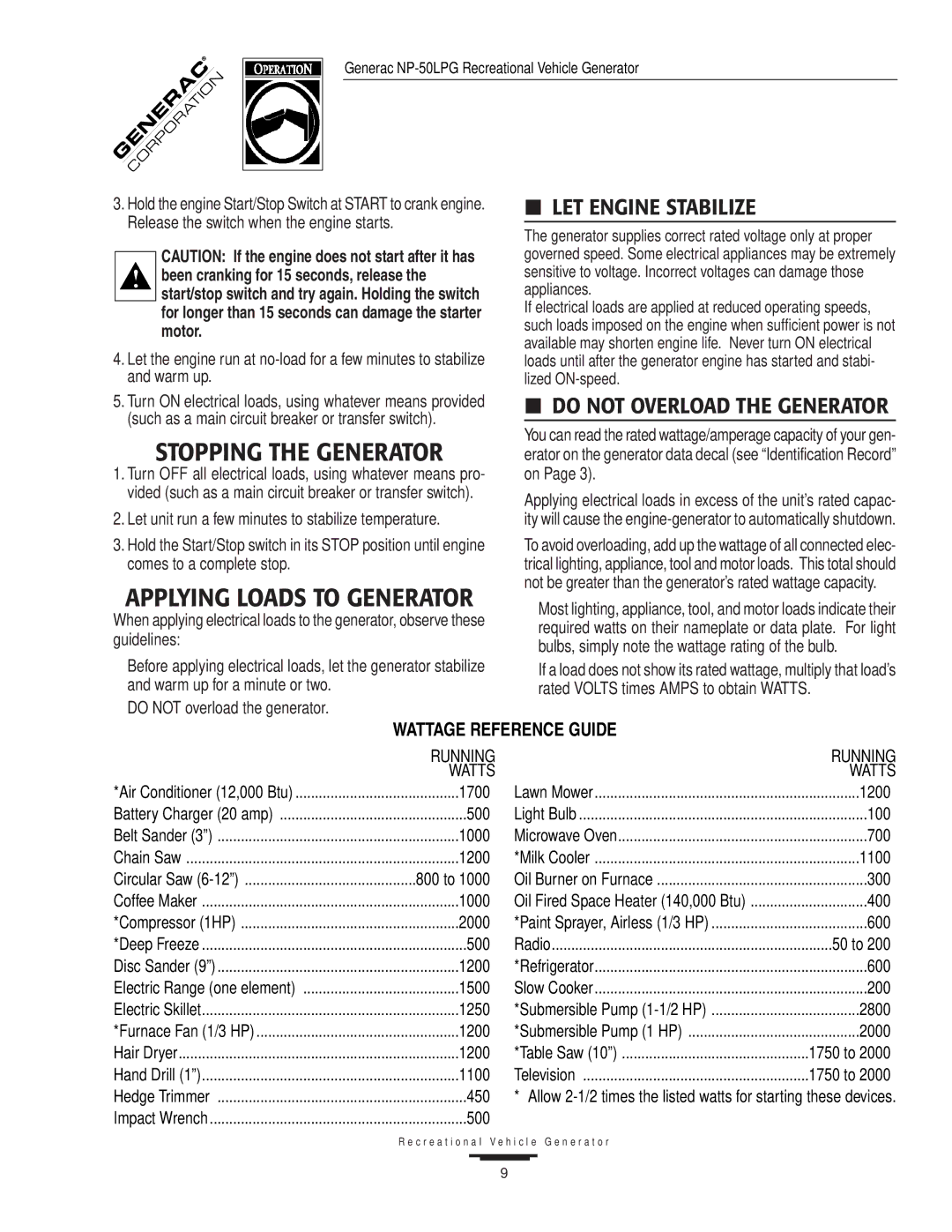
® GENERACCORPORATION
Generac
3.Hold the engine Start/Stop Switch at START to crank engine. Release the switch when the engine starts.
CAUTION: If the engine does not start after it has been cranking for 15 seconds, release the start/stop switch and try again. Holding the switch for longer than 15 seconds can damage the starter motor.
4.Let the engine run at
5.Turn ON electrical loads, using whatever means provided (such as a main circuit breaker or transfer switch).
STOPPING THE GENERATOR
1.Turn OFF all electrical loads, using whatever means pro- vided (such as a main circuit breaker or transfer switch).
2.Let unit run a few minutes to stabilize temperature.
3.Hold the Start/Stop switch in its STOP position until engine comes to a complete stop.
APPLYING LOADS TO GENERATOR
When applying electrical loads to the generator, observe these guidelines:
Before applying electrical loads, let the generator stabilize and warm up for a minute or two.
DO NOT overload the generator.
 LET ENGINE STABILIZE
LET ENGINE STABILIZE
The generator supplies correct rated voltage only at proper governed speed. Some electrical appliances may be extremely sensitive to voltage. Incorrect voltages can damage those appliances.
If electrical loads are applied at reduced operating speeds, such loads imposed on the engine when sufficient power is not available may shorten engine life. Never turn ON electrical loads until after the generator engine has started and stabi- lized
 DO NOT OVERLOAD THE GENERATOR
DO NOT OVERLOAD THE GENERATOR
You can read the rated wattage/amperage capacity of your gen- erator on the generator data decal (see “Identification Record” on Page 3).
Applying electrical loads in excess of the unit’s rated capac- ity will cause the
To avoid overloading, add up the wattage of all connected elec- trical lighting, appliance, tool and motor loads. This total should not be greater than the generator’s rated wattage capacity.
Most lighting, appliance, tool, and motor loads indicate their required watts on their nameplate or data plate. For light bulbs, simply note the wattage rating of the bulb.
If a load does not show its rated wattage, multiply that load’s rated VOLTS times AMPS to obtain WATTS.
WATTAGE REFERENCE GUIDE
| RUNNING |
| WATTS |
*Air Conditioner (12,000 Btu) | 1700 |
Battery Charger (20 amp) | 500 |
Belt Sander (3”) | 1000 |
Chain Saw | 1200 |
Circular Saw | 800 to 1000 |
Coffee Maker | 1000 |
*Compressor (1HP) | 2000 |
*Deep Freeze | 500 |
Disc Sander (9”) | 1200 |
Electric Range (one element) | 1500 |
Electric Skillet | 1250 |
*Furnace Fan (1/3 HP) | 1200 |
Hair Dryer | 1200 |
Hand Drill (1”) | 1100 |
Hedge Trimmer | 450 |
Impact Wrench | 500 |
| RUNNING |
| WATTS |
Lawn Mower | 1200 |
Light Bulb | 100 |
Microwave Oven | 700 |
*Milk Cooler | 1100 |
Oil Burner on Furnace | 300 |
Oil Fired Space Heater (140,000 Btu) | 400 |
*Paint Sprayer, Airless (1/3 HP) | 600 |
Radio | 50 to 200 |
*Refrigerator | 600 |
Slow Cooker | 200 |
*Submersible Pump | 2800 |
*Submersible Pump (1 HP) | 2000 |
*Table Saw (10”) | 1750 to 2000 |
Television | 1750 to 2000 |
* Allow
R e c r e a t i o n a l V e h i c l e G e n e r a t o r
9
